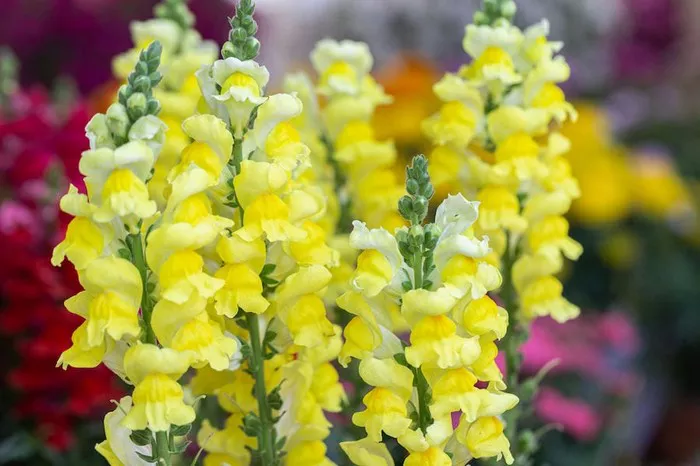Snapdragon flowers, known for their vibrant colors and distinctive shape, have long been admired in gardens around the world. But beyond their ornamental appeal, some may wonder: can you eat snapdragon flowers? In this comprehensive article, we delve into the edibility, nutritional value, and recipes featuring these delightful blooms.
Edibility of Snapdragon Flowers
Snapdragon flowers (Antirrhinum majus) are indeed edible, with a mildly sweet flavor that makes them suitable for both culinary and decorative purposes. However, it’s essential to exercise caution and consume only the petals, as other parts of the plant may contain compounds that could be harmful if ingested in large quantities.
Before indulging in snapdragon petals, ensure that they have been grown without the use of pesticides or other chemicals. Thoroughly wash the petals before use to remove any dirt or debris. Additionally, it’s advisable to sample a small amount initially to ensure there are no adverse reactions, particularly for those with allergies or sensitivities.
While snapdragon flowers are generally considered safe for consumption, it’s crucial to avoid varieties that have been treated with pesticides or other harmful chemicals. Always source snapdragons from reputable growers or cultivate them organically in your own garden for the freshest and safest blooms.
Nutritional Value of Snapdragon Flowers
Snapdragon flowers may be visually appealing, but do they offer any nutritional benefits? Surprisingly, yes! While not a significant source of calories or macronutrients, snapdragon petals contain various vitamins, minerals, and antioxidants that can contribute to overall health and well-being.
One of the notable nutritional components of snapdragon flowers is vitamin C, which plays a crucial role in immune function, collagen synthesis, and antioxidant defense. Additionally, snapdragons provide small amounts of vitamin A, vitamin K, and several B vitamins, albeit in modest quantities.
Mineral-wise, snapdragon flowers offer trace amounts of calcium, potassium, and magnesium, which are essential for bone health, muscle function, and electrolyte balance. These minerals, though present in relatively low concentrations, still contribute to overall nutrient intake when consumed as part of a balanced diet.
Moreover, snapdragon flowers contain antioxidants such as flavonoids and carotenoids, which help combat oxidative stress and inflammation in the body. Including a variety of colorful flowers like snapdragons in your diet can contribute to a diverse array of beneficial phytonutrients.
Recipes Featuring Snapdragon Flowers
Now that we’ve established the edibility and nutritional value of snapdragon flowers, let’s explore some creative ways to incorporate these blooms into culinary delights:
1. Snapdragon Salad: Toss snapdragon petals with mixed greens, sliced strawberries, toasted almonds, and crumbled feta cheese. Drizzle with a honey-lime vinaigrette for a refreshing and vibrant salad that’s perfect for spring.
2. Snapdragon Infused Vinegar: Add a unique floral twist to your homemade vinegars by infusing them with snapdragon petals. Simply place clean petals in a glass jar and cover with white wine vinegar. Let steep for several days to a week, then strain and use as desired in dressings, marinades, or as a flavorful finishing touch.
3. Snapdragon Syrup: Create a delicate syrup infused with the essence of snapdragon flowers. Combine equal parts sugar and water in a saucepan, and gently heat until the sugar dissolves. Add clean snapdragon petals and simmer for a few minutes. Remove from heat, let cool, then strain out the petals. Use the syrup to sweeten beverages like lemonade, cocktails, or iced tea.
4. Snapdragon Garnish: Use snapdragon petals as a decorative garnish for cakes, cupcakes, or fruit platters. Their vibrant colors and unique shape add an elegant touch to any dessert spread.
5. Snapdragon Tea: Steep snapdragon petals in hot water to create a delicate floral tea. Add a squeeze of lemon and a drizzle of honey for extra flavor, or enjoy it simply for its soothing aroma and subtle taste.
6. Snapdragon Popsicles: Mix pureed fruit with coconut water or fruit juice, then add whole snapdragon petals to popsicle molds before freezing. The frozen treats will not only look stunning but also offer a refreshing burst of flavor.
These are just a few examples of how snapdragon flowers can be incorporated into culinary creations. Feel free to experiment with different flavor combinations and cooking techniques to discover your favorite ways to enjoy these edible blooms.
Conclusion
In conclusion, snapdragon flowers are not only a feast for the eyes but also a delightful addition to the culinary world. Their mild flavor, nutritional value, and versatility make them a unique ingredient for various dishes and beverages. Whether used as a colorful garnish, infused into syrups and vinegars, or enjoyed as part of a refreshing salad or tea, snapdragon flowers offer a creative and flavorful way to elevate your culinary repertoire. Just remember to source them from organic growers and consume only the petals to ensure a safe and enjoyable dining experience. So go ahead, indulge in the beauty and taste of snapdragon flowers – your taste buds will thank you!

